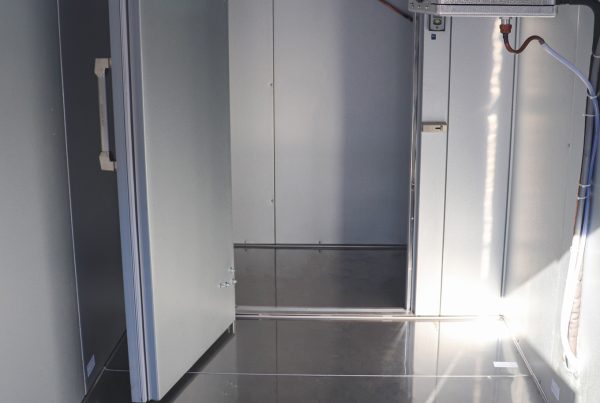If the temperature in your walk-in cooler or freezer is not optimal for the type of products you are storing, it can lead to spoilage or the spreading of food borne illnesses. Thermometers are a very important indicator to tell if your walk-in is maintaining your desired holding temperature properly. However, thermometers don’t always give accurate readings, so it’s a good idea to verify that they are working correctly from time to time.
When the thermometer for your walk-in cooler or freezer left the factory, it was calibrated to be accurate within one degree of the actual temperature. However, the thermometer may have been mishandled in transportation, or it may have lost its bearings over time; so it’s always a good precaution to test the reading against a known standard such as melting ice water. If the reading is incorrect, you will need to calibrate it.
 Dial Thermometer Calibration
Dial Thermometer Calibration
1. Remove the lens to expose the pointer by un-threading counterclockwise (threaded lens) or by carefully prying (press-in lens) the lens away from the case using the molded slots.
2. Fill a glass or insulated mug with crushed ice and add water. Stir the glass and let it sit for 5 minutes, until all the ice is melting into the water.
3. Check the accuracy by inserting the temperature sensitive probe into the center of the cup of melting ice and water (32°F, 0°C). Keep it there for at least 30 seconds and take it out when the pointer has stopped moving. If your thermometer does not read 32°F, ± 2°F, continue onto step 4.
4a. If the temperature reads high: Stabilize the pointer by placing a finger next to the left side of the wide end. Insert a screwdriver into the slot in the pointer hub and carefully turn the hub clockwise until the desired setting is reached.
4b. If the temperature reads low: Stabilize the pointer by placing a finger next to the right side of the wide end. Insert a screwdriver into the slot in the pointer hub and carefully turn the hub counter-clockwise until the desired setting is reached.1
Digital Thermometer Calibration
 Your digital thermometer should have a reset button or a recalibration screw. Follow steps 1-3 from the dial thermometer calibration instructions above. If necessary, hold down the reset button or turn the recalibration screw until you reach 32°F. The screw can be turned clockwise to decrease the reading or counter-clockwise to increase the reading.2
Your digital thermometer should have a reset button or a recalibration screw. Follow steps 1-3 from the dial thermometer calibration instructions above. If necessary, hold down the reset button or turn the recalibration screw until you reach 32°F. The screw can be turned clockwise to decrease the reading or counter-clockwise to increase the reading.2
What if the digital thermometer gives no reading at all?
Electrically Powered: Test if electrical current is going to your thermometer and that the lead connections are secure. Electrically powered digital thermometers can burn out if subjected to voltages higher than their requirements.
Solar Powered: The backup battery in your solar powered thermometer may be dead. Replace this, or let it sit in the sun for several hours to recharge. The batteries in these units may last 3 to 4 years before wearing out. Make sure your solar thermometer gets adequate ambient light to power itself (some models require a minimum of 50 lux of light; some require 100 lux or more).3 You may need to leave on a light near your walk-in to ensure the thermometer continues to function.
If you are a restaurant that is concerned with food safety, it’s a good idea to test the calibration quarterly, or before your health inspection.
1 https://www.walkincoolerparts.com/PointerReset.pdf



